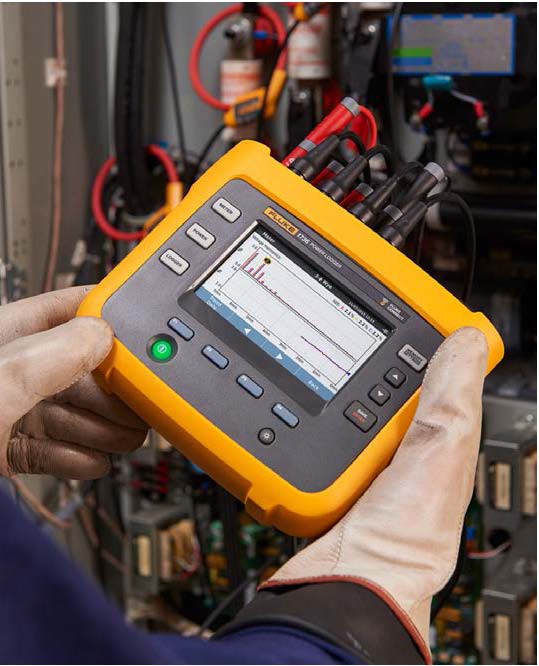The purpose of power quality measurements is to classify basic measurements of voltage and current in such a way that the state of health of the electrical system can be quantified. One of the key measurement quantities is harmonics.
Harmonics are voltages or currents with frequency components that are integer multiples of the frequency of the applied AC voltage, or fundamental power frequency.
When AC voltage is applied to resistive heaters, constant speed induction motors and synchronous motors, the current follows the voltage waveform envelope; in this case harmonics are not likely to be present as both the voltage and current are at the same frequency. On other loads, such as motor inverters, personal computers and LED lighting systems, the current is only drawn for a fraction of the time the voltage is present, which causes the current waveform to be distorted.
When this distortion occurs, it creates harmonics. These are currents at frequencies that are a multiple of the fundamental (50/60Hz) frequency.
In turn, these current harmonics can affect the voltage on the system, causing harmonic voltages. The distortion caused by the harmonics can affect the operation of other electrical equipment on the same circuit; other loads such as motors and transformers can overheat, have shortened life and ultimately fail due to the presence of harmonics. That is why measurement of harmonics on your electrical system is so important.
Acceptable harmonic distortion level guidelines
 There are guidelines on the acceptable levels of harmonic distortion; these are total harmonic distortion (THD) and total demand distortion (TDD). THD is usually considered with respect to voltage distortion (although it can be applied to current too). TDD applies to current distortion only.
There are guidelines on the acceptable levels of harmonic distortion; these are total harmonic distortion (THD) and total demand distortion (TDD). THD is usually considered with respect to voltage distortion (although it can be applied to current too). TDD applies to current distortion only.
The measurement and calculation of these two quantities is based on the international standard IEC61000-4-7, the standards title is “Testing and measurement techniques – General guide on harmonics and interharmonics measurements and instrumentation, for power supply
systems and equipment connected thereto.”
The standard describes in detail the methods to be used for calculating harmonics. This important document enables accurate comparison with suggested acceptable levels of harmonics found in other documents. Many different documents make recommendations regarding harmonic levels, including those provided by electric utilities in order to enable their network to operate safely and reliably for all connected users and to protect their network from damage and excessive energy losses.
The two main standards that have been adopted worldwide (sometimes with local adaptations) are EN50160 and IEEE519. The EN50160 standard describes a wider range of power quality measurements including voltage dips, swells, interruptions, unbalance and flicker. The IEEE519 standard focuses on harmonics alone, providing guidance for acceptable levels and discusses both voltage and current distortion, but pays particular attention to load current.
Although the standards have some differences, they also have some important commonalities; both documents reference the IEC61000-4-7 harmonics standard, the IEC61000-4-15 flicker standard and the IEC61000-4-30 standard that describes testing and measurement techniques for power quality. Additionally, EN50160 and IEEE519 suggest that measurements are made at the Point of Common Coupling (PCC).
This measurement point is typically the point at which the utility has its revenue meter connected. This agreed connection becomes the point of reference for the utility as the utility is more often concerned about harmonics on its network rather than harmonics on the users’ network.
The recommended harmonics levels in IEEE519 and EN50160 provide a good guide for users when considering whether harmonics in their facility may be causing a power quality issue. If the levels are below the recommended levels, it’s probably safe to assume that harmonics are not a problem.
Harmonic level recommendations
 These values are the limits for electrical systems operating below 1,000V for EN50160 and up to 69kV for IEEE519 and are measured at the point of common coupling:
These values are the limits for electrical systems operating below 1,000V for EN50160 and up to 69kV for IEEE519 and are measured at the point of common coupling:
The current distortion limits quoted in IEEE519 are somewhat more complicated. In this case the prospective short circuit current (Isc) is considered along with the load current (IL). The two valuesare considered as a ratio Isc/IL, this provides some insight into the impedance of the electrical source and its ability to handle harmonics.
The higher the value of Isc compared to IL the less likely the circuit will be affected by the presence of harmonics. The value of Isc can be difficult to ascertain, the electric utility may be able to provide some guidance.

Maximum harmonic current in percent IL
The limits shown here are a subset of those recommended in each of the standards. The more comprehensive range of values noted in the standard requires the user to measure and report on many more harmonics. This task can be laborious without proper reporting software; a good reporting software can considerably shorten the process, saving both time and money.
Although each set of limits is different, there is clearly some agreement on the approximate magnitude of the recommended limit value. It should be noted that these limits are at the point of common coupling. If you measure downstream from this point, you are likely to discover higher levels of harmonics. If higher levels are measured,
the next step should be to discover which loads are creating the harmonics. Once that is established, the feasibility of installing a harmonic filter should be given consideration.
The harmonic data collected while measuring will be the first point of reference when consulting a filter supplier. Harmonic filtering on individual loads is typically the most economical solution. However, if there are multiple loads creating harmonic distortion, a single filter at a point which is a common feeder to the polluting loads could be installed.



